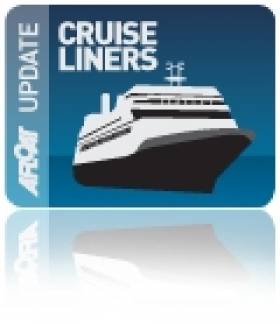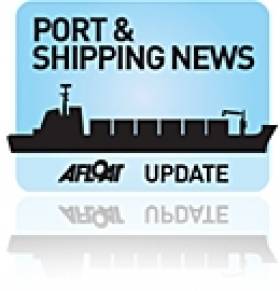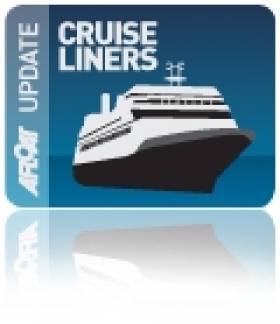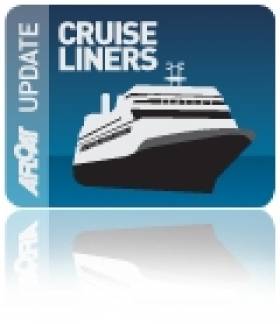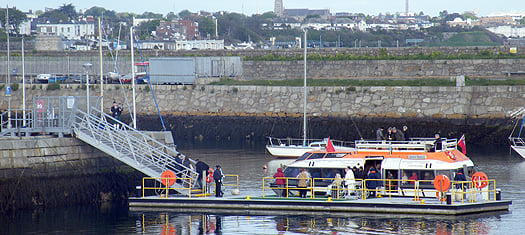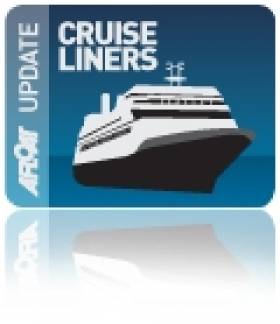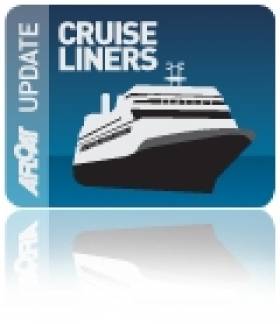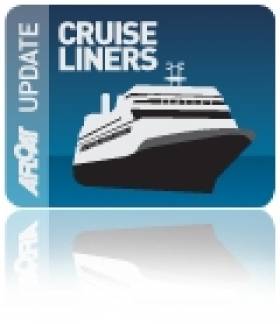Displaying items by tag: Queen Mary 2
Medevac From Queen Mary 2 Off Irish Coast Is Second In 13 Months
The Clare Herald reports on a helicopter medevac from the Queen Mary 2 off the Irish coast earlier this week.
Rescue 115 from the Irish Coast Guard was involved in the evacuation of an elderly woman to University Hospital Limerick from the luxury ocean liner on Monday afternoon (19 November).
The incident came just over a year after an elderly man with a suspected heart problem was evacuated from the same liner off West Cork.
Elderly Passenger In Medevac From Queen Mary 2 Off Cork
#Medevac - Shannon’s Irish Coast Guard helicopter Rescue 115 was involved in a medevac from the cruise liner Queen Mary 2 some 60 nautical miles off West Cork on Thursday morning (12 October), as BreakingNews.ie reports.
An elderly passenger understood to have a heart problem was treated by the ocean liner’s medical staff before transfer to the coastguard crew, who airlifted him to University Hospital Tralee.
#dlharbour – Hostile questions were asked in the Dail on Wednesday by local TD Richard Boyd Barrett on the proposed development of Dun Laoghaire Harbour as a cruise liner port. They were deflected in ministerial replies about legislation currently being drafted, and the two possible viable ways forward for the harbour's administration. But the underlying pace is accelerating towards a resolution of the future of this unique example of Victorian design, engineering and construction. W M Nixon finds that, in recent days and weeks, his views on the possible uses of this magnificent artificial harbour have undergone considerable change.
Embarrassment is a powerful stimulant for change. Change of attitude, change in ways in behaving, change in ways of looking at things, change to entrenched ways of thinking. I was hugely embarrassed by something seen in Dun Laoghaire nine days ago. And within seconds, there came a complete epiphany, with the sudden awareness that an entrenched attitude towards the development of Dun Laoghaire as a cruise liner port had turned through about 140 degrees.
It made for the complete 180 degrees, as the first 40 degrees of the turn had already been achieved a couple of weeks previously, while spending two completely absorbing if mentally exhausting hours with the maverick Alistair Rumball and his team at the Irish National Sailing School beside the inner recesses of Dun Laoghaire's inner harbour, which is still called the Coal Harbour even though it's very many years since anyone offloaded any lumps of the black gold there.
Be that as it may, as we parted we were shooting the breeze about the proposed development of Dun Laoghaire as a cruise liner port, which has been top of the local agenda since the end of March, and handily gave us one of our choicer April Fool's Day stories here on Afloat.ie - it proved so effective we had to add a health warning.
When a story provides you with something like that, you develop a certain affection for it. So while Alistair and I agreed that that the absolute dream solution for Dun Laoghaire Harbour would be a top-of-the-line government-funded National Monument Preservation Scheme, with the entire place given over exclusively to recreation afloat and ashore, and no commercial shipping of any significant size whatsoever allowed about the place, we knew it was pie in the sky.
"How on earth would they really pay for it?" he asked. "This place is huge, it costs a fortune to run and maintain. A cruise liner berth offers the best and most compact method of providing a worthwhile income stream. And as we in our sailing school – being a commercial operation – have to be rigorous in observing harbour regulations and keeping clear of the established in-harbour shipping lanes, we know that you can continue to sail small boats in large areas of the harbour without any undue sense of space restrictions".
Subsequently, I've been spending some time around Cork Harbour, where circumstances are so different from Dublin Bay that, unlikely as it may seem, you end up feeling sorry for the sailors of south Dublin. For while Cork is almost embarrassed by its riches in natural amenities for sailing, and it's all in a large and attractive harbour where marinas can be put down almost anywhere with no more than a floating breakwater to provide the necessary minimum of shelter, Dublin Bay by contrast is a hugely deprived area in terms of natural waterfront facilities for sailing, yet any attempts to provide man-made shoreline amenities for boats and sailors are dogged with local opposition every inch of the way.

Around Cork Harbour, it only needs a floating breakwater and, hey presto, you've suddenly got a marina - as seen here at Monkstown. Photo: W M Nixon
Thoughts of this struggle, and how things change, emerged again for various reasons in Dun Laoghaire nine days ago, at the reception in Irish Lights HQ to launch the Great Lighthouses Tourism Initiative. Time was when our many fine lighthouses were places of mystery, and permission to visit took quite a bit of arranging if it could be managed at all. But my word, times have changed. In this electronic age, there are those who wonder if we need all our lighthouses. Yet Irish Lights is legally obliged to maintain them, and the built structures around them.
So Yvonne Shields, the CEO of Irish Lights, whom we'd describe as very switched on and extremely bright were we not talking of the top executive in a lights organisation, unveiled this sensible scheme whereby twelve of our greatest lighthouses are being transformed into stations on a tourist trail, while continuing as working lighthouses.
As the greatest and most monumental lighthouses on land tend to be on rugged headlands in remote areas, in the eyes of Brussels they're in peripheral areas deserving special aid. So there's €2 million of Eurodosh going into this project, which sees what had become increasing liabilities being transformed into tourist resources. And if we're going to be sniffy about that, let's face it: the kind of tourist who'll want to visit a remote lighthouse will not be the kind of tourist who would keep you well clear of Temple Bar.
So the old grey matter was churning briskly away on the business of seeing lighthouses in a new way as we headed home past the Coal Harbour, and there it was: The Embarrassment. For this was the evening at the end of the day when the majestic and rather handsome cruise liner Queen Mary 2 was anchored off Dun Laoghaire in a near gale from the southwest which had delayed the morning's arrangements to ferry passengers ashore in the ship's own tenders to the special landing pontoon installed by the Harbour Company in the inner harbour.
By this time, they were trying to return on board, waiting patiently in a queue which ran the length of the inner pier and more as the two ship's tenders bustled the mile and a half plus out to the ship, yet still more buses turned up to disgorge more passengers, such that for a while the long length of the queue seemed to stay persistently the same.
Perhaps it's because we Irish don't do queuing that I found the entire thing acutely embarrassing to behold. And it wasn't even as if it was raining, which it well could have been. Nevertheless it struck me as being a Third World sort of scenario. Yet obviously these people were keen to visit Dun Laoghaire – most of the thousands of passengers on board had elected to go ashore.

This just won't do at all – images of Third World destinations came to mind on seeing the passengers from the Queen Mary 3 queuing in the Coal Harbour in Dun Laoghaire to get back out to their ship anchored in the bay. Photo: W M Nixon
So the epiphany came with the essential flashing great light. If we're going to have cruise liners calling at Dun Laoghaire, boomed this disembodied voice, then let's do it properly and provide them with a proper berth. Otherwise, don't have them about the place at all. But please, please – no more buzzing in and out in little tenders in this Irish climate, and no more queuing on a comfortless pier. It's an affront to our best traditions of hospitality.
This sudden firing-up with all the zeal of the recent convert (for until then, I'd wanted Dun Laoghaire to stay exactly as it is, and damn the expense) resulted in my being right into the dragon's den four days later. It was meant to be a short and businesslike meeting with Gerry Dunne, the CEO of Dun Laoghaire Harbour Company, to discuss the Cruise Liner Berth Proposals. But so many ideas were flying around that we ran well over time.
Please be assured, though, that I did my best to represent the needs of the boat-owning and sailing community while accepting that since Stena Sealink withdrew from running a ferry service from Dun Laoghaire to Holyhead, something very serious indeed needs to be done to pay for the maintenance of the harbour.
We have to remember that, among Ireland's main sailing centres, Cork and Kinsale are blessed with such good natural harbours that any marinas located in either harbour do not need fixed breakwaters. As for Bangor Marina on Belfast Lough, it may need a very substantial solid breakwater on its north side, but otherwise - thanks to being located in a bay - three of its four sides are naturally sheltered. But Dun Laoghaire is badly done by – it's so totally an artificial harbour in an exposed location that three of its four sides are protected by large man-made breakwaters, and while they are constructed in monumental style, continuous monitoring and maintenance is essential.
This is costly, but it would become even more so were standards allowed to slip for even a year or two. Even with the present high standards, there can be underlying wear and tear which in time needs major capital expenditure, and according to one recent report, hidden erosion on the most exposed section of the East Pier may eventually need up to €5 million for a proper remedial job.
As it is, the current basic running costs of the harbour are between €2 and €2.5 million a year. Were it kept as a purely recreational harbour and general public amenity, this figure could perhaps be slightly reduced. Yet the Dun Laoghaire recreational boating market still could not withstand paying the full amount out of its own resources and expected annual expenditure, so the shortfall would have to be made up by Government subvention.
But would the sailing and boating people of Dun Laoghaire really like to feel that they're beholden to taxpayers throughout Ireland for their continuing enjoyment of this wonderful amenity at affordable prices? There's something unpleasantly artificial about the idea of such an arrangement, whereas a harbour which is providing a modest but genuine profit is something which has a much healthier feel to it.
Surely if a way can be found of generating a worthwhile income stream without unduly distorting the traditional functioning of the harbour, then that idea should at the very least be actively explored, and recreational boating groups should be prepared to reach out towards compromises in the knowledge that, in turn, such arrangements would make the Harbour Company more accountable to all.
However, local representative Richard Boyd Barrett TD of the People Before Profit party, and Chair of Dun Laoghaire Save Our Seafront Group, sees it differently, and he has called for "a major campaign of people power against the planned cruise berth, and to protect the future of the harbour as a public amenity". His three main objections to a cruise berth plan are "(1) That the cost and financing of the project at €18 million means that the Harbour Company will have to borrow using its existing assets, where no proper business case has been produced. This puts the very future of the harbour at risk. (2) The entire plan has been hatched by an unelected board of the Harbour Company, Council Executives, and local business people who ran a sham of a public consultation over the two weeks of the Easter Holidays, and (3) The scale of the luxury liners at 300 metres long and 59 metres high will dwarf the harbour and reduce public access and public enjoyment of the most intact Victorian harbour in Britain and Ireland".
So with a Harbour Company which is government-owned, yet is charged with maximizing the economic benefit and exploiting the commercial opportunities provided by Dun Laoghaire Harbour, clearly there is something of a divide between the two sides. In fact, "light years apart" just about sums it up.
Nevertheless, politics being the art of the possible, it has to be possible to bring people together sufficiently to see that perhaps a proper sympathetically-designed cruise liner berth might indeed be the answer. After all, although it was built between 1817 and 1842 purely as a harbour of refuge for sailing ships with no thought of any interaction between sea and land, it very quickly became a ferry port for cross-channel steamships. At the height of this activity, with frequent roll-on roll-off ferries and their unpleasant shoreside traffic dominating the waterfront, Dun Laoghaire had lost much of its charm.
For the life of me I can't see that the much more limited shoreside traffic generated by the visits of cruise liners in the summer months can be seen as being anything like as obnoxious as the previous waves of road and rail traffic for the ferries, which was readily tolerated, and helped to keep the place going for 180 years.
And in any case, with the end of the ferry services, Dun Laoghaire definitely lacks purpose. In the Irish climate, it is very difficult to maintain a sense of vitality around a harbour which is purely devoted to personal recreation, whether afloat and ashore. It could be argued that, regardless of the economic benefits, it would be good for the mental spirit and communal well-being of Dun Laoghaire to be a cruise liner port of call, as a cruise liner strikes a neat balance between work and play. Like it or not, all work and no play may make Jack a dull boy, but all play and no work makes him mad.
But even if we accept that the shoreside traffic will be much less than it was with the regular ferries even if there is a cruise liner in port every other day, that is only part of the equation. How does the town itself shape up as a desirable cruise liner destination?
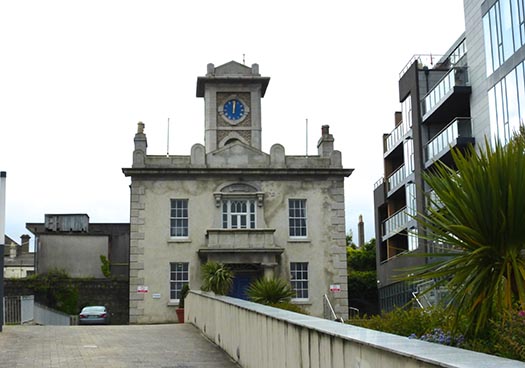
The Harbour Lodge is symbolic of today's Dun Laoghaire, a classical building from an earlier age, but now enclosed by modernity. Photo: W M Nixon
When we get down to the nitty gritty like this, Gerry Dunne is in his element. He's an affable guy, and good company, but I wouldn't like to get into a row with him, as there's steel underneath it all. So in the sedate setting of Harbour Lodge – which he cheerfully admits his opponents and friends have nick-named "Mussolini's Palace" – he's just the man to fight off the brickbats and work his way towards several objectives. But although he actually lives in Dun Laoghaire within walking distance of his office, he's not really into boat and water sports, yet that's no drawback, as personal preferences definitely don't come into it at all as he plans the way ahead.
He makes no bones about admitting that his attitude is strongly commercial. Before taking over the reins at Dun Laoghaire Harbour Company, he was Commercial Director at RTE, a job description which boggles the mind. Before that, he honed his skills in the UK, working for several large Irish food companies. If that gives you a vision of ditzy little artisan cheeses selling in agreeable country shops, then perish the thought – the big Irish food industries provide as tough a business environment as you could imagine.

The many moods of Gerry Dunne.Toughened by a varied and demanding career in business and marketing, he has brought a fresh mind to the problems of making Dun Laoghaire harbour economically viable. Photos: W M Nixon
He joined the Harbour Company in 2009, when talk of Stena's withdrawal was already in the wind. So he got Dun Laoghaire moving towards the cruise liner market in a small way, with the miniature 53-passenger Quest in 2011. Finding Quest an in-harbour berth was no problem, and she provided invaluable information on what Dun Laoghaire can provide as a USP for discerning cruise liner passengers. For Quest's rather specialist group, it was the easy access to the Wicklow Hills and particularly Mount Ussher Gardens, and they definitely didn't want to have to travel through Dublin City to get there.

The mini liner Quest – seen here in the Arctic - began the programme of attracting cruise ships to Dun Laoghaire in 2011
So far so good, but Gerry Dunne really struck gold when he started going to the cruise liner fairs in America and Europe. Gradually he built up a useful network, and again he struck gold when he got a report on the potential attractions of Dun Laoghaire from the Vice President (Itineraries) of one of the biggest American cruise liner conglomerates. Asked to sum up in one word the attraction of the Dun Laoghaire for visitors coming in from sea, her answer was: "Serenity".
We've become accustomed to Venice being talked of as The Most Serene Republic - The Serenissima. But it makes you sit up and take notice to hear of Dun Laoghaire being so described by a tough American businesswoman. Yet that's the impression the waterfront area, with its combination of the old yacht clubs, the station, the Town Hall and the Royal Marine Hotel, apparently makes on seaborn visitors from cruise liners, even if their liners are at present anchored outside the harbour and they have to be ferried in to land by ship's tenders. It seems they can blank out the less attractive buildings, and are left with the abiding impression of relaxed elegance with an easygoing way of life.
This takes a bit of getting used to, as it's so much at variance with the perception in Ireland of Dun Laoghaire as a place where they'd argue over anything and everything all the time, while just up the street there's the real problem of the dreary array of boarded-up shops. But like it or lump it, here it is folks – the reality is the yacht clubs and other other historically significant and stylish buildings of the Dun Laoghaire waterfront area – including the pleasantly under-stated Victorian residential terraces - are the town's greatest tourist asset.
Quite what some of the more senior members of the yacht clubs will make of that we can only guess, but the word is that the clubs have indicated that they'll be prepared to welcome some cruiser liner guests to their premises at pre-arranged times. So perhaps we should see the cruise liners as no more than extra-super super yachts......And there's no doubt that many rugged sailing folk from Dun Laoghaire are themselves only too happy to tootle off on a cruise liner when the peak of the sailing season is over.
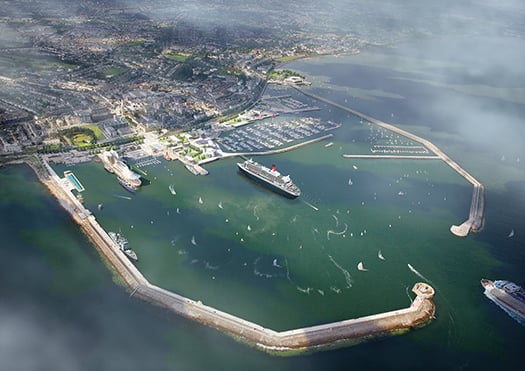
The artist's impression was just that – an artist's impression. If the new berth goes ahead, cruise liners will actually have their sterns towards the town.
But what is the reality if the new berth is agreed? Well, you can forget about your artist's impressions showing a liner facing the town. Space will be restricted, so the liners will come in stern first, thereby enabling them to make an elegant departure for the benefit of crowds down the end of the piers, which could become a popular occurrence.
The new liner pier will be as short as possible, though it will have an underpass for small craft, while the bows of the ships themselves will be held in place by dolphins, as was the HSS ferry. If you think that getting into this berth will involve impossibly ticklish manoeuvring, consider this recent photo of the three Cunard Queens up close and friendly in Southampton, and note that there's no lack of small craft nipping about among them.
 The three Cunarders can manoeuvre unaided at close quarters even with several small craft nipping about their heels, as seen here in Southampton
The three Cunarders can manoeuvre unaided at close quarters even with several small craft nipping about their heels, as seen here in Southampton
One of the other drawbacks about the current setup, with the ships anchoring off and people disembarking in the Coal Harbour, is that there's very little space for buses to move about, but the present waterfront marshalling yard left behind by the exit of Sealink will greatly relieve that problem if the new berth is built. At the moment, it is planned that passengers will walk the short length of the pier to reach their buses, but my own feeling is that the pier should be made a bit wider with a turning circle in order that passengers may board their buses almost directly from the ship, for we're not talking long distance athletes here.
That said, those who are fitter can come and go as they please, with the town within easy reach, whereas being anchored off can cause cabin fever. In other words, if Dun Laoghaire is going to have a cruise liner berth, let it be done properly – half measures involving long walks to buses just won't do, but equally for those who do walk, the town must feel accessible and welcoming.
As to the amount of space the ship will take up in the harbour, that will vary from ship to ship, but some are indeed enormous. And their wind-deflecting presence will certainly add an extra interest to in-harbour dinghy racing. As for the interest of the in-harbour racing for the visitors on the ship, that in turn will all be part of Dun Laoghaire's colourful charm, for which their ship will provide a grandstand view.
In line with that, we should remember that the leading in-harbour class, the historic Water Wags, have only just returned from showing themselves off at Morbihan Sailing week in France. Thus they'll scarcely be unduly bothered about providing a source of fascination for passengers on cruise liners, some of whom will probably be former dinghy racers themselves.

The Water Wags find it easy to sail freely within Dun Laoghaire Marina on their way out to race in the main harbour, so their only problem with a cruise liner berthed in mid-harbour will be the effect it has on wind flow. Photo: W M Nixon
But what the in-harbour dinghy racers are already becoming happily accustomed to is the newly-emptied eastern half of the harbour, with space now provided where boats used to moor. And this area will not be at risk from maneuvering cruise liners – there's not the depth for them. Finally, as to the height or otherwise of the ships in relation to other structures in Dun Laoghaire, I think we've been righteously indignant about this on a mistaken premise – since the new library was pushed into place, all bets about skyline heights and an elegant relationship with other waterfront buildings are clearly off.
So if the sailing and boating community can be more accepting of the cruise liners which will ultimately provide a real source of income to maintain the harbour which makes their activities possible, what can they expect in return?
They're in a strong negotiating position. After all, the Harbour Company's research has shown it is the comfortable presence of the yacht clubs which underpins this vision of serenity which is Dun Laoghaire's most appealing attraction for the kind of people who enjoy the cruise liner experience. So it's very much in the Harbour Company's interest to keep the clubs in good health.
By today's standards, the Royal Irish YC is thriving, thanks in no small part to its location within the marina against whose creation, ironically, the club fought tooth and nail. But the other three clubs – the Royal St George, the National, and the Dun Laoghaire MYC – are blighted by the limited and relatively unsheltered pontoon berthing at their clubhouses.
It may well be – and I'm only guessing – that the Marina Company's agreement with the Harbour Company includes a clause that these three clubs are not allowed to have their own adjacent marinas. But if such a clause exists, then it should be deleted for the greater good of the harbour and the vitality of the waterfront in general, and the three clubs should be facilitated in providing 150-boat marinas – with proper breakwaters for the George and National - in front of each clubhouse.

Dun Laoghaire from the southeast. If the new cruise liner berth is installed at mid-harbour, a longterm plan could be the installation of breakwaters in front of the Royal St George YC and the National YC in the foreground to shelter two new 150-boat marinas, as the location of the Royal Irish YC within the main marina gives it an unfair advantage in providing facilities for its members.
As to how Dun Laoghaire town can benefit, that's another matter altogether. The much stronger income and improved employment going through the Harbour Company will undoubtedly be a tangible good, though how seasonal it will be – with liners expected only between April and October – remains to be seen.
But personal expenditure by cruise liner passengers in the town is an imponderable. In fact, some cruise liners in the popular sunshine destinations are notorious for disembarking guests who feel that they made their total investment with the purchase of the ticket back home, so they don't plan to spend any more.
The historic little Venetian city-port of Dubrovnik on the Adriatic – which doesn't have a proper liner port – recently banned cruise liners from coming anywhere near the place, as their thousands of passengers made the narrow streets very uncomfortably crammed at peak times, yet the average expenditure ashore in Dubrovnik by each cruise liner passenger was precisely €6. There's food for thought. But we will of course get a better class of cruise liner passenger in Dun Laoghaire...
#queenmary2 – 'What is the name of the big, blue ship off Dun Laoghaire?' might well be a common Google search next Wednesday, May 20th when the Queen Mary II anchors off Scotsman's Bay at 7am. Interest in cruise liners was at a high this week for the start of the Cruise Ship season into Ireland when Royal Princess Cruise Liner passengers were welcomed at Dun Laoghaire on Tuesday and equally on Monday when the longest ever ship, the MSC Splendida cruise liner docked in Dublin Port.
RMS Queen Mary 2, the world's largest ocean liner made her maiden visit to Dublin Bay a year ago and returns almost a year to the day into Scotsman's Bay next Wednesday.
Another five star welcome is in store for some 3,000 passengers who will be greeted by a piper and Irish dancers, tour guides, free wireless and business offers after docking at the Coal Harbour.
The RMS Queen Mary II is the second of a flotilla of more than 20 floating visitors to Dún Laoghaire this year, bringing over 100,000 cruise passengers. This compares with just 200 passengers arriving in the harbour in 2012.
RMS Queen Mary II departs Dun Laoghaire just before low tide at 6pm next Wednesday.
Ports & Shipping Review: Galway Port 99%, X-Bow Call, Detained Cargoship, Cruise Liffey, New Pilot RIB and QM2
#ShippingReview: Over the last fortnight Jehan Ashmore has reported from the shipping scene where plans for the expansion of Galway Harbour are "99 per cent ready to go".
The increasing strategic importance of Cork Harbour as a base for the oil and gas energy sector was clearly evident with the call of the unusual looking 'X-Bow' platform supply vessel Bourbon Clear.
A High Court judge expressed concern for the crew of Clipper Faith, a Belize registered 19,000 tonnes cargo ship detained in Dublin Port who have not been paid since late last year.
As referred above the Clipper Faith which has been in the port since March shifted berths so to accommodate French cruiseship Le Boreal to the East-Link toll-bridge.
The 'cruise' berth is situated much closer up the Liffey and is where larger visiting cruiseships are to moor as Dublin Port plans to develop deep-water berths for a proposed new cruise terminal.
Irish Rigid Inflatable Boat (RIB) builder Red Bay Boats is exhibiting one of its giant 16–metre Pilot Boat Stormforce RIBs at next month's Seaworks commercial exhibition in Southampton.
On the same day of the historic call of the dual serving liner and cruiseship Queen Mary 2 off Dun Laoghaire, expedition cruiseship Serenissima docked within the harbour walls, while another caller was made by Artania to neighbouring Dublin Port.
#QM2Farewell– Queen Mary 2 under the command of master Kevin Oprey, weighed anchor in Dublin Bay yesterday evening after her historic maiden visit off Dun Laoghaire Harbour and from where a flotilla set out to take a final close-up view of the massive majestic liner, writes Jehan Ashmore.
She is certainly a vessel of superlatives, being the longest, tallest, widest and most expensive liner ever built, when launched in 2003. Among the facilities on the 14 deck liner are a 3D cinema and a planetarium.
Over 35 nationalities from every continent in the world including Ireland!... were represented among the passengers, with the majority coming from Germany (1,400) followed by the UK (760) and the US (200).
Today the liner is berthed at Liverpool Cruise Terminal. Her debut call to Dublin Bay is her third visit in Irish waters, following Cobh in 2011 and an anchorage call off Dunmore East, Waterford Estuary in 2005.
The QM2 had spent more than half a day in Dublin Bay while at anchorage with tenders kept busy plying to and fro to the passneger pontoon in the Coal Harbour while crowds of onlookers took to the seafront to view the impressive liner.
Her visit marked a significant milestone in the changing fortunes of Dun Laoghaire Harbour, as the Holyhead fast-ferry HSS Stena Explorer in recent years has reduced to a seasonal-only service. When introduced in 1996, the HSS fast-craft carried up to five round-trips daily.
To get a sense of the sheer size of the QM2 she is 72m high (keel to funnel) compared to the HSS fast-craft which is only 27.5m.

Anchor aweigh... starboard side of the liner. Photo Jehan Ashmore
The call by the famous Cunard Line 'flagship' is a major coup for Dun Laoghaire Harbour and the visit is estimated to generate a spend of €400,000 alone to the area.
Following the successful launch of the 2014 season by the QM2, the port also welcomed yesterday the small cruiseship Serenissima which docked within the harbour walls.
Over the next two months a further six cruise vessels are scheduled to visit, among them is P&O Cruises 710-passenger Adonia, which is due next week.
In total the port is to welcome be 14 callers bringing 30,000 passengers and generate an income of €3 million.
The cruising business is a growing market sector in the tourism industry and where Dun Laoghaire Harbour Company is to capitalise in this market with plans to develop a dedicated cruise terminal as part of the 'masterplan'.
The facility will be able to accommodate much larger cruiseships than present and with vessels up to 340m long.
#LinerQueenMary2 -RMS Queen Mary 2 the world's largest ocean liner made her maiden visit to Dublin Bay, anchoring offshore in calm sunny conditions off Dun Laoghaire Harbour early this morning.
A five star welcome saw 3,000 passengers greeted by a piper and Irish dancers, tour guides, free wireless and business offers after docking at the Old Coal Harbour.
The RMS Queen Mary II is the first of a flotilla of 14 floating visitors to dock in Dún Laoghaire this year, bringing over 30,000 cruise passengers, and generating an income of €3 million for the area. This compares with just 200 passengers arriving in the harbour in 2012.
The QM2 -the longest, tallest, widest and most expensive liner ever built - departed Greenock in Scotland yesterday for Dún Laoghaire and she will continue voyage this evening to Holyhead and Liverpool, followed by Invergordon, Stavanger in Norway and then Hamburg in Germany.
Over 35 nationalities from every continent in the world (including 6 from Ireland!) were represented among the passengers, with the majority coming from Germany (1,400) followed by the UK (760) and the US (200).
A 'mini cruise-festival' this afternoon, will celebrate the Queen Mary 2 arrival with family entertainment, boat trips circling the ship, face painting, a complimentary vintage bus, live music and dancing and special offers throughout the town.
Queen Mary 2 passengers disembark at the recently installed passenger pontoon in Dun Laoghaire's Coal harbour. Photo: Jehan Ashmore
Don McManus, Chairman of the Dún Laoghaire Business Association says excitement is rife among the Dún Laoghaire Business community: "The arrival of the Queen Mary 2 marks the beginning of a new era for Dún Laoghaire. The business community has been hugely supportive in funding the cruise welcome and associated publicity. The Queen Mary 2 alone will generate a spend in the region of €400,000 for the area. We have big plans to continue with the rapid development of the lucrative cruise market in the coming months and years."

The liner makes an impressive site from the Dun Laoghaire shoreline. Photo: Jehan Ashmore
"The cruise ship market is the fastest-growing sector in the travel and leisure industry. Globally, it is experiencing accelerated growth of 7.2 per cent per annum despite the tourism industry declining overall. It generates direct spend in Ireland in excess of €20 million per annum, however this is a tiny fraction of the €27 billion the market is worth globally.
"The continuous expansion of the market has increased demand for additional destinations for cruise line operators. By responding to the high standards set out by the cruise companies, Dún Laoghaire is capitalising on this opportunity and we anticipate rapid year on year growth for Dún Laoghaire in the industry."
"Research conducted by Fáilte Ireland in 2010 revealed that over 80% of passengers disembarking in Ireland considered Ireland an important destination in their itinerary. The opportunity is enormous. Dún Laoghaire is seizing this opportunity. By responding to what they want, we will attract the business."
The initiative is supported by Dún Laoghaire Harbour Company, Dún Laoghaire Rathdown Co. Council and the Dún Laoghaire Business Association.
PR from Dun Laoghaire Harbour Company Below:
Visit of Queen Mary 2 a Milestone in Development of Dún Laoghaire as Cruise Centre
Today (Thursday, May 16th) marks a significant milestone in the development of Dún Laoghaire Harbour as a location for visits by cruise ships, with the arrival this morning of the Queen Mary 2, flagship vessel of the famous Cunard line.
Around 4,000 passengers and 1,000 crew were on the vessel that arrived at 7.00am and will remain moored off the harbour until around 6.00pm this evening. Six further cruise vessels are expected to visit Dún Laoghaire Harbour over the next two months with a total of 14 expected over the full season.
Speaking after the arrival of the Queen Mary 2 this morning, the CEO of Dún Laoghaire Harbour Company, Gerry Dunne, said: "This is an historic day for Dún Laoghaire Harbour and augurs well for our plans to develop the harbour as the key port along the east coast for cruise visits."
"The cruise line business is a growing market sector in the tourism industry. Ireland has recently begun to capitalise on this market and over the last few years has succeeded in attracting a growing number of visits by cruise liners. However, the number of trips to Ireland represents a very small share of this potential market and the opportunity exists to grow this business to the Irish economy very significantly."
"Working with the Dún Laoghaire Cruise Stakeholder Group the Harbour Company has engaged in a vigorous marketing campaign, particularly in the United States, to enable Dún Laoghaire to tap into this lucrative market."
"To ensure that the harbour is also capable of catering for the 'new generation' of larger cruise vessels, the Stakeholder Group has initiated a Pre-Application Consultation with An Bord Pleanála under Section 37 of the Planning and Development Act, 2000 in regard to proposals for the construction of a new quay in Dún Laoghaire Harbour to cater for vessels of up to c.340m long. This is entirely consistent with the designation of Dún Laoghaire under the recently published National Ports Policy as a centre for marine related tourism and recreational activities."
"The visit of the Queen Mary 2 shows the potential of this sector of tourism to deliver significant economic benefit to Dún Laoghaire, the Greater Dublin area and the country in general".
#LinerQueenMary2- Queen Mary 2 is currently underway and bound for Dublin Bay, having departed Greenock Ocean Terminal, where she launched the cruise season at the Clyde port. Tomorrow morning the world's only 'liner' will make her historic maiden anchorage call off Dun Laoghaire Harbour, writes Jehan Ashmore.
The 345m Cunard Line 'flagship' was the first of five cruise call scheduled in just six days to visit Greenock from where the 2,600 passenger capacity liner mostly with passengers from Germany, had embarked on a cruise starting in Hamburg.
The call of Queen Mary 2 to the Scottish port is apt in that her predecessor Queen Elizabeth otherwise affectionately known as the 'QE2' was launched downriver on Clydebank at the John Brown shipyard and entered service in 1969.
The famous liner served on the trans-Atlantic 'liner' route until replaced by the considerably larger Queen Mary 2 or also referred as 'QM2' ' in 2004. Only twice has the Queen Elizabeth 2 visited Dublin Bay, on both occasions anchoring off Dun Laoghaire Harbour.
As the expectations rise of the arrival of Queen Mary 2 on the horizon of Dublin Bay so too will the looming giant all of 151,400 tonnes. The French built liner was launched in 2003 from the Chantiers de l'Atlantique shipyard in St. Nazaire near Nantes.
At around 06.00hrs tomorrow, a pilot cutter from Dublin Port will meet Queen Mary 2 on the fringes off the bay from where the 14 passenger deck ship will edge ever closer to anchor around an hour later some 1.2 nautical miles north-east of the East Pier lighthouse, which should give an excellent vantage point.
From around 07.30 tender craft from the liner are expected to shuttle to and fro to the cruise-dock tender pontoon in the Coal Harbour, where a 'five-star' welcome will see passengers greeted by a piper and Irish dancers as they embark.
A 'mini cruise-festival' for both cruise and domestic visitors will include family entertainment, face painting, a complimentary vintage bus and live music and dancing and special offers throughout the town.
In addition special QM2 themed boat excursions will be circling the liner during the afternoon before the liner is scheduled to depart around 17.30hrs.
It is estimated the visit to local economy will be boosted by €400,000 and places Dun Laoghaire Harbour on the map as a port of destination for larger international cruise operators.
#LinerQueenMary2 -Final preparations are underway as Dún Laoghaire gears up for the first ever visit of the world's only ocean liner – the giant RMS Queen Mary 2.
The impressive Cunard Line 'flagship' all of 151,400 tonnes, is due to anchor offshore of Dun Laoghaire Harbour on Thursday morning, at around 07.00hrs.She has a 2,600 passnenger capacity and a crew of 1,200.
Her inaugural call is to bring a €400,000 boost to the local economy during her one-day visit!
In total €3m is to be generated from the 2013 cruise season with 14 arrivals bringing 30,000 passengers to Dún Laoghaire Harbour. In stark contrast to last year when the port handled just 300 passengers.
A five star welcome will see the QM2 passengers greeted by a piper and Irish dancers as they embark at the old Coal Harbour, where the cruise-dock pontoon was installed last year for use by such large deep-drafted vessels and their tender craft.
To get around the town, a shuttle bus will bring passengers to receive a warm welcome in the grounds of the Royal Marine Hotel, where guests will be greeted with mini-samples of Guinness, character actors from local tourism sites.
A bespoke 'tourism office' with volunteers will provide tourism information and handing out booklets of vouchers and offers for shops, restaurants and tourism outlets in the area.
In addition a Dún Laoghaire phone app has been specially developed for cruise passengers to maximise enjoyment and avail of special discounts and offers while touring the town.
The Dún Laoghaire Cruise Stakeholders' Group has also installed an advanced wireless facility in Dún Laoghaire so passengers can enjoy extensive free internet access throughout the town itself and extending as far as the cruise liner during their stay.
A 'mini cruise-festival' for both cruise and domestic visitors will include food and craft markets, family entertainment, boat trips circling Queen Mary 2 and there is to be live music aired throughout the town.
Don McManus, chairman of the Dún Laoghaire Business Association says excitement is rife among the Dún Laoghaire Business community: "The arrival of the Queen Mary 2 on Thursday marks the beginning of a new era for Dún Laoghaire. The business community has been hugely supportive in funding the cruise welcome and associated publicity. We have big plans to continue with the rapid development of the lucrative cruise market in the coming years. Last year saw the arrival of just two cruise ships carrying 300 crew and passengers.
Following the establishment of a Dún Laoghaire Cruise Stakeholder Group and an aggressive international marketing strategy, this year we will welcome fourteen cruise ships with over 30,000 passengers and crew!"
The initiative is supported by Dún Laoghaire Harbour Company, Dún Laoghaire Rathdown Co. Council and the Dún Laoghaire Business Association
#LinerQM2 – A once in a lifetime opportunity to see fantastic close-up views of the giant Queen Mary 2 (QM2) during the liner's historic inaugural call off Dun Laoghaire Harbour are available with a Dublin Bay Cruises excursion, writes Jehan Ashmore.
The Dun Laoghaire based operator is running two special cruises to circle the 2,620 passenger QM2, the world's only liner during her 'anchorage' call next Thursday (16 May). Cruises depart from the East Pier (15.30 and 17.00) and head into Dublin Bay where the 151,400 tonnes Cunard Line 'flagship' will tower above the excursion boat St. Bridget.
Queen Mary 2 was built at the famous shipyard of Chantiers de l'Atlantique, St. Nazaire, France and cost €659m (US$800 million). The liner entered service in 2004 and to give a sense of her sheer size, she is 1,132 feet long, 236 feet high, 135 feet on the beam and has a draft of 32 feet.
Among the facilities, there are 15 restaurants and bars, five swimming pools, a casino, ballroom, theatre, spa-club, the only planetarium at sea and a 3D cinema. The Bermuda flagged liner which has 14 decks has a crew of 1,200.
She was named after the original Queen Mary which remains moored as a static floating hotel in Long Beach, California. Uniquely the Queen Mary 2 continues the tradition of the trans-Atlantic 'liner' which reflect a bygone era of the classic voyage between Southampton and New York.
Her call follows her predecessor the 70,000 tonnes Queen Elizabeth 2 (QE2), which twice made anchorage calls offshore of Dun Laoghaire more than a decade ago.































